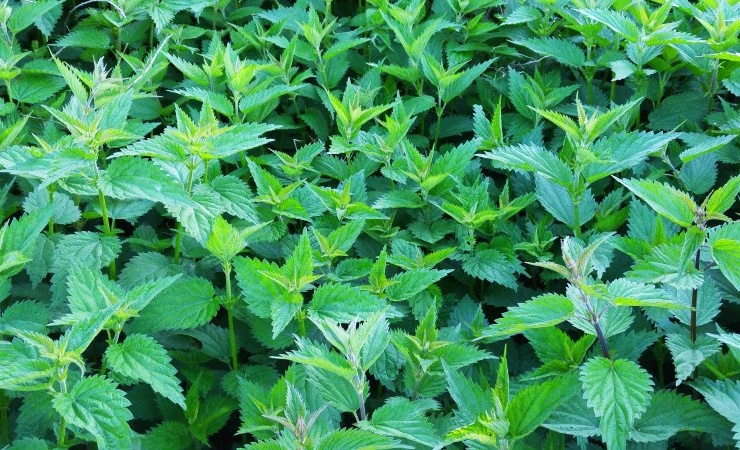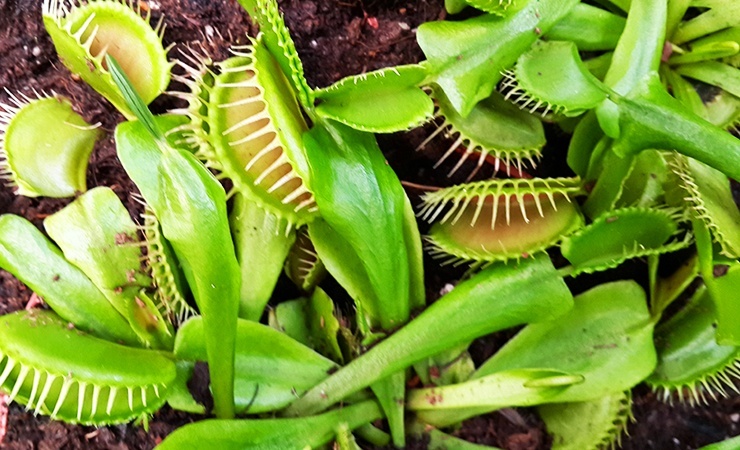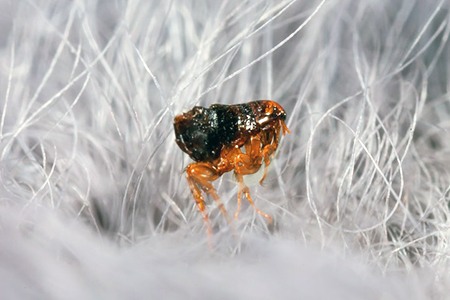7 Plants That Repel Fleas & Provide Secondary Benefits You'll Love
Author: Jen Worst | Editor: Omar Alonso
Review & Research: Jen Worst & Chris Miller

Imagine your home; your sanctuary being invaded by tiny nasty fleas just waiting to attack. Although they can't fly, these little creatures can certainly jump (up to 7" vertically and 13" horizontally.) Thankfully there's plants that repel fleas, indoors and out.
Nothing can make you feel uncomfortable in your own home quite like creepy, crawly bugs that are waiting around to bite you when you least expect it.
Whether your four-legged friend brought them in, or they found their own way; if you need some help getting rid of fleas and don’t want to spray chemicals constantly, consider planting some some of the beautiful flowers and herbs below.
You’ve probably heard about flowers that can attract butterflies and other types of strategic gardening, but did you know that a flea repellent plant can also help in the opposite way?
While fleas prefer to feast on dogs and other animals that aren’t human, they’ll still take whatever they can get, which includes biting you and even spreading infections to humans like typhus and cat-scratch disease.
The Best Plants That Repel Fleas at Home
Let's take a look at the seven best options for keeping these pests out of your yard and house (or at least out of the rooms we spend the most time in). Most of these plants also repel ticks, which will be a huge bonus to your outdoor pets.
1. Basil

Quick care tips: Plant in well-drained soil, warm temperature, at least six hours of sunlight per day, fertilize once per month, water often when it’s hot out, prune for greater output.
Safe for pets?: When fresh it’s non-toxic to pets, but be careful with extracts and essential oils.
Also helps repel: Mosquitos, asparagus beetles, whiteflies, carrot flies.
Everybody should grow some basil on their windowsill regardless of pest problems. It’s amazing for fresh tomato sauce.. Basil has a strong odor that humans love, but pests don’t like it at all.
Some people like to mix a handful of basil leaves with a few ounces of hot water in a sealed jar. Once it’s cooled down, put it in a spray bottle to mist around the home. Not only will your house smell like an Italian grandmother’s kitchen, but you’ll help keep the pests at bay.
2. Mint

Quick care tips: Use light mulch when planting mint outdoors, keep the soil moist, wipe off the leaves if they get dirty, water regularly, mint is very easy to care for.
Safe for pets?: Generally non-toxic to cats and dogs, but some warn that the English pennyroyal species of mint is toxic for dogs to ingest.
Also helps repel: Aphids, cabbage looper, flea beetles, squash bugs, whiteflies.
There are many varieties of mint, and this plant is great for cooking, baking, and making mojitos. Mint is most commonly an outdoor plant known for running wild and taking over the garden if you don’t keep an eye on out, but mint is very easy to grow indoors.
Some people love to have huge mint gardens outdoors and they even encourage their dogs to walk through it to get the scent on them.
Mint plant is generally safe for dogs unless you’re using peppermint oil or if the dog is eating more than a couple of leaves here and there, so be very careful with essential oils around pets.
3. Catnip for Fleas

Quick care tips: Rich loam soil with good drainage, soil pH of 6 - 7.5, full sun or grow indoors under T5 fluorescent bulbs.
Safe for pets?: Cats love it for relaxing, but it also makes some dogs act very hyper.
Also helps repel: Ants, flea beetles, aphids, weevils, cabbage looper, cockroaches.
Good news for all the cats who are reading this; catnip is a great deterrent for fleas. It won’t kill the fleas or permanently scare them away, but they hate the smell so it definitely helps to keep them at bay, and most importantly, away from you and your pets.
It’s said to be the minty smell that repels fleas, so any plants that have a similar profile should be helpful.
4. Chrysanthemums

Quick care tips: Well-drained soil, at least five hours of direct sunlight, water weekly.
Safe for pets?: Toxic to pets if ingested in large quantities, so keep them out of reach if you have pets that like to snack on plants.
Also helps repel: Roaches, ants, ticks, beetles, and all types of bed bugs and types of silverfish.
These plants produce beautiful flowers which is just an added bonus on top of the Chrysanthemums’ ability to repel fleas and ticks and other pests.
This plant contains Pyrethrin, which is effectively an insecticide that attacks the nervous system of pests and prevents them from biting which drastically reduces how annoying and dangerous these pests can be. Beyond that, it also repels them.
5. Rosemary

Quick care tips: Well-drained sandy soil works best, six to eight hours of sunlight, they like warmth and humidity.
Safe for pets?: Generally safe, but avoid ingestion of Rosemary essential oils or putting high doses on their fur where they could lick it off as it can be toxic in high doses.
Also helps repel: Flies, mosquitos, cabbage moths.
People use rosemary to create sprays or to make essential oil drops that they’ll put on their dog’s coat to repel fleas. Like basil, rosemary is also a nice herb to have around the house, so it serves an additional purpose beyond repelling pests.
Rosemary water is used as a natural flea bath by pet owners who want to avoid baths that use any types of chemicals.
6. Venus Flytrap

Quick care tips: Use pots with good drainage with a 1:1 mixture of gardening sand and peat moss, water with distilled or rainwater only, 12 hours of direct sunlight, feed them bugs by hand if they aren’t getting enough on their own.
Safe for pets?: They can be harmful to pets if ingested.
Also helps repel: It’s not a matter of repelling, they’ll flat-out eliminate bugs like ants, beetles, spiders, and slugs.
Ready to call in the heavy artillery? Venus flytraps aren’t the most practical plants in the world, and they can be tricky to keep alive even for the most experienced green thumbs, but they’ll straight up eat any bugs that dare to get close to them.
Granted they may lean more towards the novelty side of things than a practical way to fight off a huge flea infestation, but if you can keep them alive they can absolutely make a difference.
7. Lavender

Quick care tips: Well-drained soil, full sun, deep but infrequent watering (wait until it’s almost dry), prune after they bloom.
Safe for pets?: In oil form, it can be harmful to cats and can cause allergic reactions in some dogs, make sure you heavily dilute if you’re turning it into oil and start with very small amounts on your dog’s coat.
Also helps repel: Moths, scorpions, fleas, flies.
Lavender produces gorgeous, deep purple flowers. It’s often used for relaxation, to help with sleep, and to help reduce anxiety. Beyond that, all the types of lavender also help to scare away all sorts of pests.
It helps in conjunction with other efforts but probably isn’t potent enough to get rid of a flea infestation on its own. The same goes for many of the plants and tips mentioned here, it’s all about the big picture and doing a lot of little things.
Where to Put Plants That Repel Fleas

Some plants thrive indoors, some need the direct sunlight that they can only get from being outside. In any case, here are some locations around the home that are optimal for planting flea repelling plants.
Wherever your pet spends time: If there’s a certain part of the yard where your pet is prone to lounge around or play in, that’s a perfect candidate of a place to put these plants.
Windows: Fleas can sneak in your windows, so having some plants in the windowsills isn’t just beneficial for the plants to thrive in sunlight, but it also demotivates the fleas from trying to sneak in.
Perimeter around your home: Fleas can sneak in through the foundation so having some plants in the basement with grow lights, or planted right outside your home to form a perimeter can help keep fleas away.
Entrances: Keeping some of these plants in containers or in the ground, either inside or outside (or both) of your home’s entrances helps to fortify one of the most common entry points for fleas to get into your house.
Near your pet’s bed: If your pet has a bed or favorite blanket they love to lay in, this will be a hotbed for fleas, so consider putting some potted plants nearby. Something fragrant like peppermint or spearmint will do the trick. Around the dog house in the yard is perfect, too.
Make sure you're taking care of your plants or the next question you might be searching is "Where do spider mites come from?" They'll take residence in these plants and though they won't spread around your home, they'll feast on your plants and harm their potency.
Other Ways to Get Rid of Fleas Quickly

I recommend against relying entirely on plants to get rid of a flea problem. Think of plants as a preventative measure that can also help once the fleas are in your home, but you’ll still need to do a deep clean and stay on top of things moving forward.
Otherwise you risk an infestation as they lay eggs and multiply. Though they may not have the longest lifespans, they can create a ton of spawn in that time period.
Get Rid of Fleas Indoors:
- Sweep your floors often and vacuum your furniture and rugs, especially if you have the types of rugs with a tall nap. Make sure you vacuum underneath your sofas. Empty the bag or canister outside!
- Move your couches and tables to reach any dark places with the broom or vacuum because fleas love the dark. The problem with using any types of brooms is that the fleas will hop away after you disrupt them, so you should definitely opt for a vacuum if possible.
- If you decide to fog or use sprays, do multiple treatments because new fleas can hatch even after you’ve sprayed.
- A steam cleaner on a high heat setting along with soap can do a real number on fleas. Steam your furniture, bed, rugs, etc.
- Wash your pet’s bedding (and yours) in hot water and dry on the hottest setting.
Get Rid of Fleas Outdoors:
- Keep your grass short and rake often. Bag it and seal it instead of composing, they will thrive in your compost.
- Cedar chips, from most types of cedar trees, spread in the areas where your pets like to hang out in the yard can help, along with putting cedar chips near flowers and garden plants.
- Nematodes are small worms you can purchase that will help regulate by eating things that fleas thrive off of. They also eat fungus gnat larvae.
Flea Diseases in Humans
Can fleas carry disease? Absolutely. Bites and annoying itches aren’t the only reason to dread fleas because they can also transmit diseases to humans.

It’s not something to lose too much sleep over since it’s relatively rare but it is still a real risk to keep in mind, especially in certain parts of the world.
Here are some of the diseases that fleas can carry and spread to unsuspecting victims:
Allergies: These are less severe than some of the other conditions we’re about to look at, but still worth mentioning. The saliva from fleas can trigger dermatitis, and some people will even have symptoms similar to asthma.
Tungiasis: It’s transmitted by the burrowing flea (chigger), and most likely to affect your feet. It’s rare to find it in North America, but it’s a real concern for people travelling to tropical parts of the world.
Bubonic plague: This is probably the most well-known disease that can you get from a flea, and it’s serious business. In its prime, it killed millions upon millions of people.
Today, it’s much less common, with only a few cases popping up in the Southwest. The bubonic plague is carried by rodents who get bitten by fleas and then go on to bite pets and humans.
Tapeworm: Fleas can pass parasites onto humans and pets, too. Tapeworms are the most common example of parasites from fleas that can harm our pets, and it usually happens if a pet accidentally eats the flea.
While these diseases aren’t common, you still increase your risk proportionally to how many fleas are hanging around your home, so let’s get rid of them, shall we?
Final Flea Repelling Plant Considerations...
I lean towards recommending plants that serve more than one purpose. For example, Chrysanthemums offer the benefit of acting as an insecticide but they also look nice. Fresh basil is absolutely lovely to have on hand and it works as a repellent to bugs on top of that.
You get the picture. Why plant something that serves one single purpose, when you can enjoy numerous benefits for your gardening efforts?
If the fleas have already taken hold on your poor pets, don’t sit around planting seeds and thinking that will fix things. You should seek more immediate treatment to rid your pets of their discomfort and any risk of disease.
Nonetheless, plants that repel fleas can be an effective long-term strategy to ensure these pesky little monsters decide to live elsewhere.
You'll Also Enjoy:
- 14 Plants That Repel Spiders Indoors & Outdoors With Little Effort
- Natural Spider Repellent: 9 Safe Spider Deterrents for Your Home & Yard
- How to Get Rid of Fungus Gnats - Quickly & Permanently
- 21 Plants That Repel Ticks: Fresh Smells We Love & Ticks Hate!
- Where Do Spider Mites Come From? (Prevention Tips & More)



